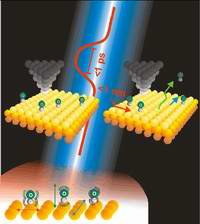 A femtosecond laser pulse, which lasts one quadrillionth of a second, can treat visual impairments and identify malignant tumors. Furthermore, it serves as an excellent tool for medical treatment as the laser can drill a nanoscale hole into cell membranes, allowing genes to be introduced into cells.
A femtosecond laser pulse, which lasts one quadrillionth of a second, can treat visual impairments and identify malignant tumors. Furthermore, it serves as an excellent tool for medical treatment as the laser can drill a nanoscale hole into cell membranes, allowing genes to be introduced into cells.
Approximately 64% of Germans are unable to see without glasses or contact lenses. One in two adults suffers from myopia or hyperopia and may benefit from laser surgery, thus the femtosecond laser is being used increasingly. This type of laser can focus through cellular tissue directly to the area needing treatment, helping to reduce time and accelerate the healing process.
However, there are drawbacks; excess radiation emitted directly into the retina can lead to vision impairment. Mr. Karsten Konig and his colleagues at the Fraunhofer Institute for Biomedical Engineering (Germany) are researching ways to eliminate these side effects.
Mr. Konig explains that the research team is working to delicately remove tissue components while precisely utilizing special low-energy pulses of a few nanojoules. This can be achieved by a powerful femtosecond laser with high pulse intensity, capable of focusing the beam with high precision using optical lenses produced by Zeiss.
The laser has been utilized in nanolaser therapy, a new field involving the diagnosis and treatment of individual cells. Depending on the intensity of the laser and the optical lenses used, the system can function as a femtoscope microscope, offering the ability to view living tissue cells with accuracy thousands of times greater than electron microscopes.
The research team has successfully demonstrated the world’s smallest knife, capable of cutting into living tissue with a width of just 70 nanometers. This opens new possibilities for gene transfer using lasers, as foreign gene materials can attach to living cells thanks to pulsed lasers without damaging the cells.
According to a German magazine


















































